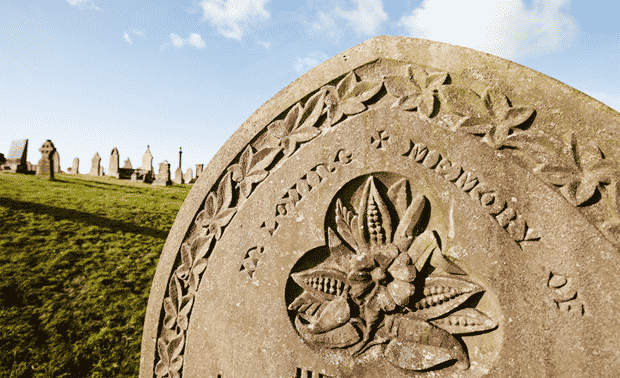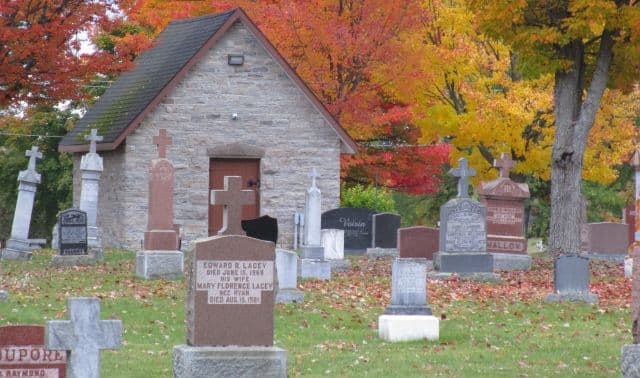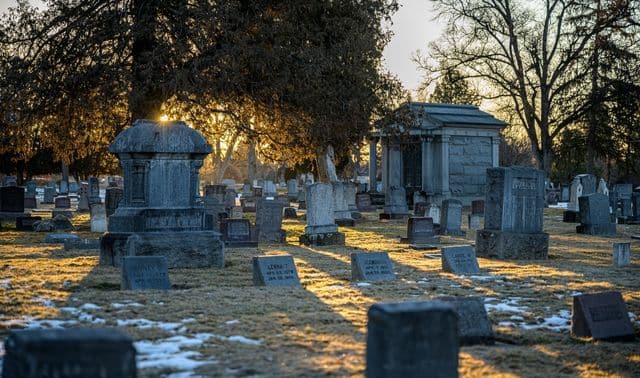Sign up for the Family Tree Newsletter! Plus, you’ll receive our 10 Essential Genealogy Research Forms PDF as a special thank you.
Get Your Free Genealogy Forms
"*" indicates required fields

Do you love everything about doing genealogy research in the cemetery—finding family burial places, studying the old stones with their intricate designs, taking in the peaceful landscape, discovering old records in the cemetery office?
In The Family Tree Cemetery Field Guide, veteran genealogist, blogger at A Grave Interest and self-described “tombstone tourist” Joy Neighbors introduces you to different types of cemeteries and helps you find your ancestors’ burial sites, understand tombstone symbolism and uncover cemetery records you didn’t realize existed.
Get to know to Joy and find out about her fascination with cemeteries in this interview.
What turned you into a tombstone tourist?
Joy: It all began with a picnic. I was on a date with a guy (who later became my husband) who took me to a cemetery with a hamper of great food and a bottle of wine. He spread out a blanket near the lake and we talked about our lives, our views on life and death, and our interest in art, and somewhere in there, I forgot I was in a cemetery. I was just sitting outdoors having an amazing evening.
We married two years later and we’ve been visiting cemeteries ever since.
It was more than 25 years later when I decided to write A Grave Interest and share this forgotten history and art.
How many cemeteries have you’ve visited?
Joy: I’ve visited everything from huge city cemeteries to a cemetery located in the middle of a highway. Brian (my husband) is on the lookout for cemeteries when we travel. We spot one from the highway and we’ll detour. Every cemetery is different but they’re all worth a visit because you never know what finds are waiting.
Let’s just say I’ve been to thousands of cemeteries, but I’m always looking for the next one to visit.
When I was young, my sisters and I would hold our breath when we drove by a cemetery. What strange cemetery superstition have you encountered?
Joy: As a child, I was told not to count the cars in the funeral procession or your funeral would be the next one to drive by. I was a kid who counted everything: steps, train cars, clouds, so that was tough.
There are so many superstitions about death and burial. Here are just a few that I’ve come across:
- Never point at the funeral procession, it will bring bad luck.
- If it rains in an open grave, it brings bad luck to the family.
- Flowers and grass grow on the graves of those who have lived virtuous lives. Only weeds or mud will cover the grave of someone who was evil.
- Never whistle in a graveyard, you are summoning the Devil.
- Never take anything from a cemetery; the dead may follow you to get it back.
- If there is thunder following a burial, the deceased has reached heaven.
What’s your favorite cemetery (and why)?
Joy: It’s so difficult to choose. If I narrowed it down by size, my favorite large cemetery is Cave Hill in Louisville, Ky. The artwork there is phenomenal and the history is amazing. It’s an older cemetery that has maintained a modern edge with its monuments, sculpture and stained glass. Plus, it’s very haunted. (And yes, I have stories from visiting.)
For a medium-sized cemetery, I’m torn between Highland Lawn in Terre Haute, Ind., and Oak Hill in Evansville, Ind. Highland Lawn has great symbolism on the stones, mausoleums and a wealth of history. Most of the town’s historical figures are buried there. (It’s haunted, too.) Oak Hill has tons of tree stones (my favorite), and rolling vistas with huge oak trees. The Civil War burial ground is one of the best designs I’ve seen.
I love small cemeteries because they’re so intimate. You really have time to get to know who’s buried there, and I like to read the stones and wonder what life was like.
Could you share something surprising about cemeteries that you’ve found most people don’t know?
Joy: A cemetery is one of the most exquisite (and inexpensive) places to hold a wedding. The grounds are beautifully landscaped and manicured, and covered with sculpture, architecture, stained glass and other art. It is truly like getting married in an outdoor art museum.
If the cemetery has a chapel, there’s also the advantage of having an indoor wedding option. Cemeteries are just starting to embrace this idea, so if it’s something you’d like to do, don’t be afraid to approach them.
If readers remember one piece of advice from The Family Tree Cemetery Field Guide, what do you want it to be?
Joy: Never stop digging! I loved Nancy Drew mysteries when I was a girl, and that’s how I approach cemetery research. It’s all a mystery; I just have to figure out how to find the clues. And those clues could be hidden in records, family Bibles, photographs or symbols on stones. Even the people themselves may hold the answers—or the clues.
I hope that the Cemetery Field Guide inspires others to become tombstone tourists and enjoy all the history and art that our cemeteries have to offer.
FamilyTreeMagazine.com is a participant in the Amazon Services LLC Associates Program, an affiliate advertising program designed to provide a means for site to earn advertising fees by advertising and linking to affiliated websites.








